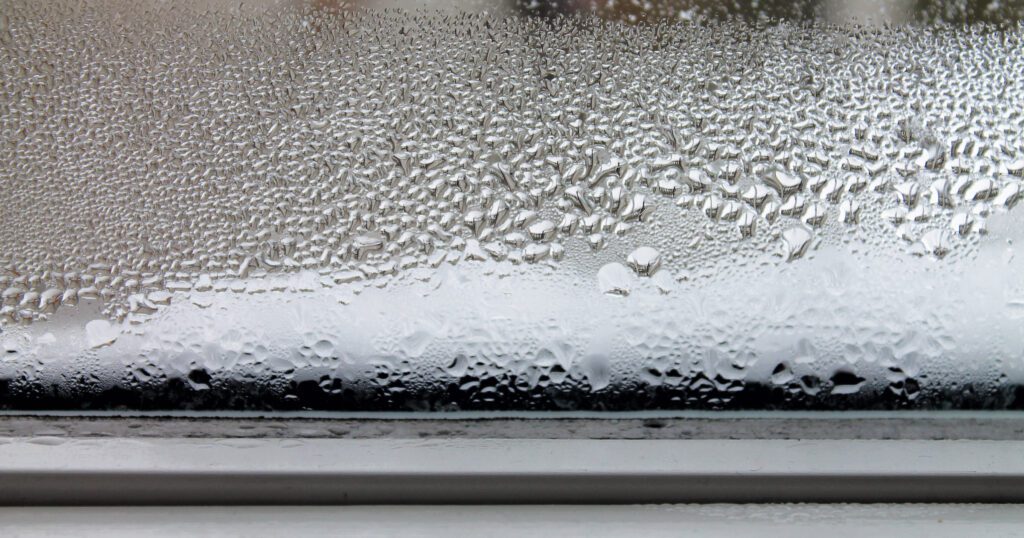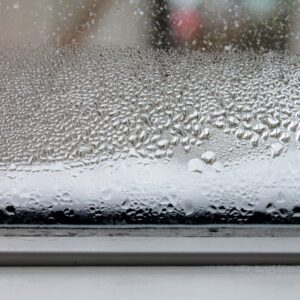Interior condensation
What to do about condensation?
Condensation, what a nuisance! Even the best ventilation system in the world and the best performing windows cannot guarantee that this phenomenon will never occur.
Fortunately, there are simple and effective ways to prevent condensation on your windows 1 :

- Avoid lowering the indoor temperature.
- Don’t close blinds and shades in the evening. This will allow the heating system to warm up the windows.
- Turn on the kitchen hood and bathroom fan.
- Make sure your dryer is connected to an air vent leading outside.
- Don’t unnecessarily prolong your showers.
- Remove screens during the winter.
- Clean ventilation grills regularly.
- Do not store firewood in the basement.
- Limit the amount of plants in the house.
Fogging, a climatic phenomenon!
In winter, when the temperature drops rapidly, the air can no longer hold the same amount of water vapor. For the same volume of air, the relative humidity level soars until it reaches its saturation point of 100%.
Usually, the excess water vapour is deposited on the coldest surfaces, i.e. the glass of windows and doors. This phenomenon is accentuated when the window frame forms a shelf that deprives the bottom of the glazing of heat.
Maximum tolerated humidity before condensation | ||
| Outside Temperature | Clear Thermos | Low-E Thermos |
| 0 °C | 50 % | 63 % |
| -10 °C | 38 % | 50 % |
| -20 °C | 26 % | 40 % |
| -30 °C | 18 % | 30 % |
| -40 °C | 12 % | 23 % |
Efficient windows will help reduce this climatic phenomenon. But under certain extreme conditions, condensation is almost inevitable. For example, when the outside temperature drops from -10°C to -30°C in a few hours, the glazing is affected. If the humidity level does not follow the curve of the drop in outside temperature, condensation is almost certain to occur.
The composition of the energy glass
Double-layer energy-efficient glass is well suited to the Quebec climate and meets the Novoclimat standards sponsored by Hydro-Québec.
Between the layers of energy efficient glass, the space is filled with argon, an inert, odorless, colorless and therefore stable and safe gas. In each sealed glass unit, a layer of silver particles is also applied. When exposed to air, silver oxidizes. Argon’s properties ensure that the metal does not deteriorate. In addition, since argon weighs more than air, it tends to concentrate at the bottom of the glass. The bottom of the window then becomes more efficient. As a result, the risk of condensation is reduced.
Ambient air is a gas which, depending on its temperature, contains more or less vapor. The warmer it is, the more moisture it can hold without creating a problem. Notice that the window glass never fogs up when it is 30°C and the relative humidity is 95%. The reason? When a gas is heated, its molecules move apart, leaving more space for water vapor.
What to do if you can’t see clearly?
When the problem of fogging of your windows persists, it is because your glass has lost its winning properties that make it perform well. It is not always necessary to replace your windows completely. Did you know that a simple replacement of your insulating windows also called “thermos glass”, can be an economical solution to restore the clarity of your windows!
Need more information about this process? Ask Jeanne your question!
See clearly with Solutions Fenêtres !
1 https://www.apchq.com/entrepreneurs/technique/chroniques-techniques/questions-et-reponses-techniques/comment-peut-on-reduire-la-formation-de-condensation-sur-le-vitrage-d-une-fenetre2 http://thermosrn.ca/wp-content/uploads/2021/11/Condensation-Interieure.pdfSee clearly!
Interested?
Spring is just around the corner. Our TIPS for the maintenance of your windows!
When spring arrives, so does the washing of your windows! ...


